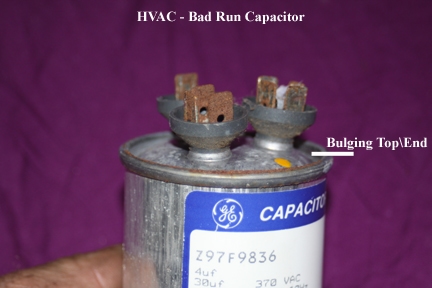A common misconception is that your air HVAC system will simply cease to work until a bad capacitor is replaced with a new, functional capacitor. Sure, there are a few easy ways to diagnose a capacitor that has completely failed, such as bulging, swelling, or liquid oozing from the capacitor, but unfortunately, it’s not always that simple!
The truth is, even though your HVAC system is running, you could possibly have a bad capacitor. You see, Capacitors are rated for a certain capacitance, and unless measured, you would have no way of knowing. This is one of the many reasons why it is imperative to have regular maintenance done on your HVAC system. A bad capacitor that is left on an HVAC system can cause irreversible damage to the component it controls. In some cases, burning up compressors and motors can cost an arm and a leg in repairs. For instance, some of the working parts on your system that may be controlled by a capacitor are the blower motor, compressor, and outdoor fan motor. If you have ever replaced one of these components before, you know you don’t want to have to do it again!
How do I measure the Capacitance?
Capacitance is measured with a digital multi-meter using what is called Micro-Farads. On many meters, you may find a symbol like this  or “MFD”, which is the setting you will want to be on in order to take your measurement. Next, make sure all power is disconnected from your HVAC system and confirm with your meter that there is no incoming voltage. Carefully remove the leads connected to said capacitor and short out the capacitor using a well-insulated tool such as needle nose pliers or a flat-head screwdriver by touching each end at the same time. Measure the capacitor with your meter set to Micro-Farads by connecting each of your meter leads to both ends of the capacitor and compare your finding with the replacement suggestion from the manufacturer that will usually be found on the side of the capacitor. It will usually look something like this: +6% – 6%. This means that if your capacitor gains or loses 6% or more of its value, it is time to replace it. Note that the percentage may change from manufacturer to manufacturer.
or “MFD”, which is the setting you will want to be on in order to take your measurement. Next, make sure all power is disconnected from your HVAC system and confirm with your meter that there is no incoming voltage. Carefully remove the leads connected to said capacitor and short out the capacitor using a well-insulated tool such as needle nose pliers or a flat-head screwdriver by touching each end at the same time. Measure the capacitor with your meter set to Micro-Farads by connecting each of your meter leads to both ends of the capacitor and compare your finding with the replacement suggestion from the manufacturer that will usually be found on the side of the capacitor. It will usually look something like this: +6% – 6%. This means that if your capacitor gains or loses 6% or more of its value, it is time to replace it. Note that the percentage may change from manufacturer to manufacturer.


